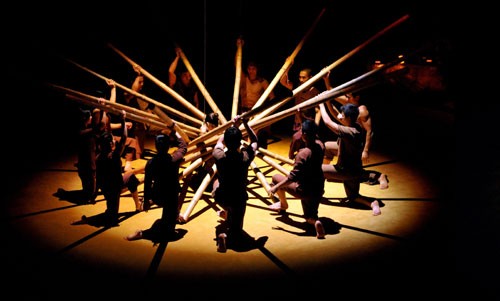Vietnam’s cultural integration
Van Thieng- Phuong Thuy -
(VOVworld)- Vietnam became a member of the ASEAN Community on December 31st, 2015. This creates a chance for Vietnam to further promote cultural integration and its cultural identity.

Circus performance "My village" |
Culture has always served as a bridge linking Vietnam with the world. In recent years, Vietnam’s rapid international integration has created opportunities for Vietnamese people to experience different cultures and lifestyles. Differences in languages, customs, tradition and lifestyles are major obstacles to Vietnam and other countries in promoting cultural integration. In its history of national construction and defense, Vietnam considers integration an important factor in enhancing national strength. Historian Duong Trung Quoc said: “Under the Ly dynasty, Vietnamese people worshipped Confucian accepted Chinese as their national scripts while still maintaining their Vietnamese language and Vietnamese cultural traditions. While moving southward, Vietnam has accepted Khmer, Champa, Phu Nam, and then Oc Eo culture. Such cultural diversity proves our firm stance and serious consideration for integration”.
Vietnam’s firm cultural stance and historical developments are the advantages for Vietnam’s integration. People’s Teacher- Professor Nguyen Quang Ngoc of the Institute of Vietnamese Studies and Development Sciences said culture has its own rules of evolution and always self reforms. Ngoc said it’s important to define advantages and disadvantages that Vietnam will face during its cultural integration into the ASEAN Community. Mr. Ngoc said: “During the ancient time, Dong Nai culture developed rapidly. Then, due to impacts of foreign cultures from India and other countries which entered Vietnam via the sea, Dong Nai culture developed into Oc Eo culture, which served as a foundation for the development of Phu Nam Kingdom. It proved that impacts of foreign cultures could not change Vietnamese culture but created a good opportunity for our culture to prosper”.
Due to its geographic location, Vietnam is the meeting place of East Asian and sea and island cultures of Southeast Asian countries. Thousands of years under Chinese domination, wars, and contacts with the Western culture in the early 20th century – all have made Vietnamese people’s cultural integration easier. But it’s important to maintain core Vietnamese cultural values. Cultural perception also plays an important role in promoting Vietnamese products overseas as it helps prevent cultural shocks. Historian Duong Trung Quoc stressed the need to promote cultural diversity: “We need to create a consensus between cultures but at the same time ensure and preserve cultural diversity. We need to focus on this aspect otherwise we will deplete Southeast Asian cultural foundation”.
Van Thieng- Phuong Thuy